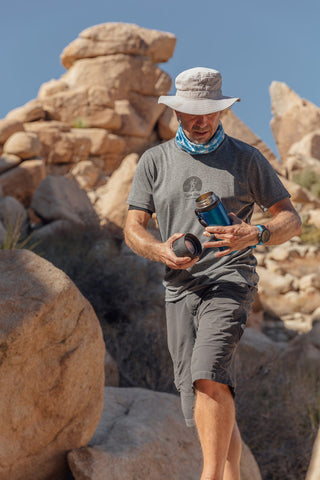In this trail-test, I take the 72 hour insulin cooler out on a number of expeditions to see where this product shines and where it doesn't.
It’s dimensions are 8.3cm (3.3″) diameter and an internal volume of 900 ML (30 oz)
Its lightest weight (empty) is 387 g (13.5 oz)
for storing insulin at temperatures between 2º C – 26º C (36º F – 80º F).
Check out the lab results at the bottom
For many outdoors activities, it works really well.
I have listed some activities below, testing the capabilities of the insulin cooler.
Here’s what I found:
Beach Day
The beach is one place sure to get a lot of sun, so to protect your precious insulin from baking in the heat, under direct sunlight, it’s nice to have this temperature-controlled vessel to store the insulins in.
Wether keeping just a vial and a syringe, or a collections of pens and needles, there’s even room for glucagon.
This is one cool place to store the medicines.
Using the freezer gel and the standard lid, there's room to keep things cool for a few hours at the beach.
With or without the freezer bio gel, the USB powered lid can create a portable mini fridge.
Long Road Trips
Another place this cooler works really well is on long road trips.
Depending on space and length of the USB cable, it can travel under the seat, in the back seat, in a cup holder or on the floor.
With USB power:
- With the USB powered lid, there’s no need to bring the freezer bio gel.
- There’s usually USB power available in most cars.
Without USB power:
- If there’s no USB power, then the freezer bio gel will have to travel along.
- Bio gel can keep the contents of the cooler cold for a couple days.
- Refreeze the bio gel at the next motel, or the destination

This one in a Prius barely fits.
At The Crag
Insulin staying protected and cool while climbing.
For a few of us outdoorsy diabetics, we really love to climb. Outdoor rock climbing areas are rugged, remote, and often exposed to the elements and unprotected from the sun.
The stainless steel case is durable enough to bounce around with my climbing gear in the backpack, although I did get the blue metallic finish a little scratched up while shooting on this climb day at my local crag.
Cool, fresh insulin when needed.
Desert Camping
Here's another place where this product really comes in handy.
It can get really hot in the daytime here in the Mojave Desert, and knowing theres a safe place to keep my insulin cool and protected from the heat and the sun in harsh environments like these, I can relax and enjoy this magical landscape.
Keeping the insulin pens cool in the desert sun.
Connecting the USB lid to my GoalZero solar panel to chill down the bio gel before the sun sets.
Getting the fire started for dinner in the desert.
Desert Treks
Exploring the vast Mojave.
Adventures in the desert!
To continue our desert adventure away from the campsite, we often venture out into the desert with off-road vehicles and spend the days exploring geological sites, scrambling around majestic rock formations, and discovering hidden desert oasis'.
Our desert day supplies need to come along for the ride, including any medications the explorers might need along the way.
Here's where a solar charger is really handy.
Day Hikes
Here's where the 72hr insulin cooler takes a break from the outdoors activity, and makes better use of its capabilities back at base camp.
While the cooler is just too big and heavy to carry along in small day packs, we will need to pair down to a smaller, lighter insulin carrying vessel.
Pairing down for fast and light travel.
Moving fast and light with smaller day packs.
Leaving Insulin at the Trailhead
Leaving my critical backup insulin in the car at the trailhead is a good safe practice, especially for hikes that are planned for only a few hours out, HOWEVER... there needs to be a way to protect the insulin from the heat.
The bio gel pack will keep backup insulin safe and cool inside the car for a couple days if the container remains closed tight and unopened, no matter how hot the car gets on the inside.
A safe backup to leave cold in the car at the trailhead.
Keeping the leave-behind backup supplies cool.
It's a common practice for me to leave backup supplies at the car when I'm out on a day-long adventure in the mountains, and just as important is to make sure my supplies are temperature controlled.
I usually bring only fast acting along with me on a day hike. Insulins like Afrezza are perfect for day hikes because they don't need to be refrigerated.
When I was using a pump, my insulin would be traveling with me, but in case of a pump fail during the hike, I'd need a backup vial and syringe waiting for me at the trailhead for when I return.
Enjoy the day hike, knowing the backups are safe and cool at the trailhead.
Backup supplies temperature controlled.
Group Outings
With group expeditions there are often opportunities to share some of the load especially with communal items that everyone will be sharing.
In Type One Outdoors group outings, there may be a unique opportunity for one T1D hiker to carry all the insulin of all the other T1D's in the party, and keep it all cool and protected for the length of the outing.
Sharing the Weight
for a day hike.
As long as we know whose insulin is whose
Backpacking
Here's where I need to make critical choices and compromises in regards to size and weight.
I normally carry 2 pens (and needles) in a cooling pouch which is: ~150 g (!5.25 oz)
and my quick acting Afrezza in a cooling wallet which is: ~280 g (~10 oz)
Jumping up to the larger metal insulin cooler puts my insulin weight to: ~820g (~1 lb 13oz)
An increase of ~670 g (~1.5 lbs)
Choosing the right size and weight to carry in the pack.
This weight / volume compromise is the factor that may (pardon the pun) "break the hikers back"
when deciding which insulin cooling method to carry along a backpacking expedition.
If it's a personal / solo expedition, I'll have to go with the lighter / Cooling Pouch option.
However, when backpacking with a group, there's always the opportunity to share the load .
Sharing the load
for an over-nighter
Notes
Pros
The functionality of the insulin cooler is what makes this work well in hot, environments.
- Keeps insulin cool. (much colder than a pouch)
(see lab temperature results below)
- Durable in rough, outdoor places.
- Can fit in most carry-along scenarios.
- Protects medicine from light.
- Can hold a multitude of insulins including vials, pens, pumps, pills, glucagon, Afrezza, etc. along with other temperature-sensitive medications.
Cons
It really comes down to personal preferences here.
- Weight
Can become an issue when pairing down weight for carrying in a pack.
Its lightest (empty) weight is 387g (13.5 oz)
Its heaviest (full) weight is 950g (about 2lbs) - Size (volume)
Can be an issue when space is very limited.
Its outside volume is ~ 1,212 cm³ or 1.21 l. (74 in³) - Tech
The only tech part is the USB lid.
It’s really a personal thing of mine, and I try to avoid bringing extra tech into the backcountry due to the risk of failure. But even if the USB lid fails, the contents will stay cool if the smaller metal lid is used with the freezer gel..
From their Lab Tests
Temperature Tests:
How many pens can it carry?
(these quantities are assuming pens only, no additional freezer gel pack)
(Experience and thoughts on general use from https://typeoneoutdoors.com/72hr-cooler/ )














































Comments
4AllFamily Customer Care Team said:
Hi Leslie,
The battery pack is now on stock and available here: https://4allfamily.com/collections/4allfamily-insulin-cooler/products/20000-mah-power-bank
It can keep the cooler with power for around 8-10H. To know how many you need, we’d need to know how long your trip is from home to arrival at your destination. Some of our coolers can keep medications refrigerated for more than 30 hours even without electricity.
Let us know if we can help with more info,
Best,
4AllFamily Customer Care Team
Leslie Ushiro said:
When will you get the battery pack 20,000 for $34.99 back in stock? I am going to need enough batteries for a trip from Hawaii(OGG) to Japan ( Haneda Airport, HND). How many battery packs am I going to need? I will be leaving Hawaii on
April 4th.
Thank you.
Leslie Ushiro